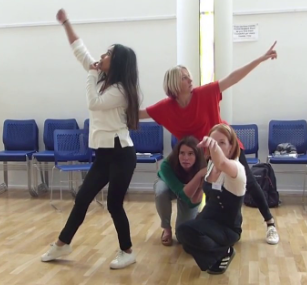If you've played "frozen statues" as a kid, you know how much fun playing "Bible Story Freeze Frame" can be when teaching Bible stories 
The basic technique:
- Actors "freeze" their pose/action when directed as they are acting out a scene that's being narrated to them.
- Actors may also listen to a certain part of a story, and then be asked to "pose the part where the friends cut a whole in the roof" (for example). After a photo is taken of several versions of that pose, the story continues until they are asked to pose another portion of the story.
Some people call this the "Tableaux" or "Pose the Scene" technique. In the next post below this one are two secular videos explaining various kinds of "Tableaux" or "Freeze Frame" techniques.
Using the "Freeze Frame" technique to dramatize Bible stories has a lot of lesson benefits:
- It is easy for all ages
- It requires almost no setup
- It doesn't require actors to memorize lines or hold a script
- It focuses on body language, non-verbal expression, and movement.
- Freeze Frames are easy to capture in photos that you can review and reflect on after the drama.
- And its fun! In fact, "Freeze Frame" feels more like "playing a game" than putting on a show.
"Staging" can be minimal, if any.
Simple props and costumes can really make the scenes pop and help characters get into character, In some drama "classes," the actors wear different or same color shirts, if not costumes, to get in character and help differentiate who's who in the drama and photos.

 Recording the "freeze frames" with your cellphone for showing afterward on a large screen creates a great opportunity for reinforcement, discussion, and further insights. (Kids also love seeing themselves on screen and laughing -- both of which are great memory makers).
Recording the "freeze frames" with your cellphone for showing afterward on a large screen creates a great opportunity for reinforcement, discussion, and further insights. (Kids also love seeing themselves on screen and laughing -- both of which are great memory makers).
Kids who don't feel comfortable acting can help by being readers, propmasters, photographers, and offering "posing" suggestions.
You can also play games to freeze scenes, such as, "switch characters/costumes/pose with the person next to you!" or by having actors move and act as they hear the story narrated --until you yell "freeze" (which freezes the actors and pauses the narrator!) You can shout "unfreeze" and then "freeze again" to get them to change and create another photo opportunity. You can play a version of acting out a story as it is being narrated called "Red Light, Green Light" which introduces a bit of random fun and excitement into the acting out of scenes.
Posing After the Story is Read. In this version of Freeze Frame, after reading the script, you assign "scenes and actions" from the story to pairs or groups of students to step forward and "sculpt" or pose each other. (The scenes/actions can also be randomly drawn from a hat.) When they have the pose figured out, drop the screen for the other students to see (and take a photo). You can also do this in front of the screen and have one student pose the other to represent a character and moment in the story. Students can shout ideas to the "sculpter" and "poser." there are lots of options to this "pose and sculpt" approach. As the actors show their pose, the director or other students can give suggestions and new actors can be invited to join the pose if they have something to add (or the director invites them to). "We need more amazed people in the crowd around Jesus!" etc.
Story Scripts can be read by a narrator(s) as actors act and then paused by the narrator or director who says "freeze." You can also pause the narration and say, "you have five seconds to create a pose of Jesus meeting the ten lepers" for example), and then yell "freeze." Story scripts can also be read by the group and the broken down into several scenes to pose (see "Posing After the Story" above).
When working with story scripts, adjust them to include more action and reaction words/cues like, "Suddenly they were all amazed when Jesus forgave the man laying on the mat."
After quickly reading through the story together, the teacher/director can have the student "rehearse" various scenes/poses and give suggestions. This is a great time for student input and you can more than one "freeze frame" if you have more than one good suggestion. The more photos and opportunity for input, the better the engagement will be!
After a quick rehearsal, your narrators can then begin to read the script as the actors start to pose the scene. Shout "...and freeze!" to stop their positioning when you think they're ready and have someone take a photo.
Save your life application for photo-viewing time. Concentrate now on capturing the scene.
The options are many. Adjust based on your kids, the script, and the needs of the story.
Suggest. Don't over-direct. Some children may need more cues and examples than others.
Scene Changes:
You can show your drama to an audience, asking them to "close their eyes" as actors change the scene, or, simply by raise and lower a sheet attached to a rope or long pole. This bit of staging helps actors get ready and adjust.












